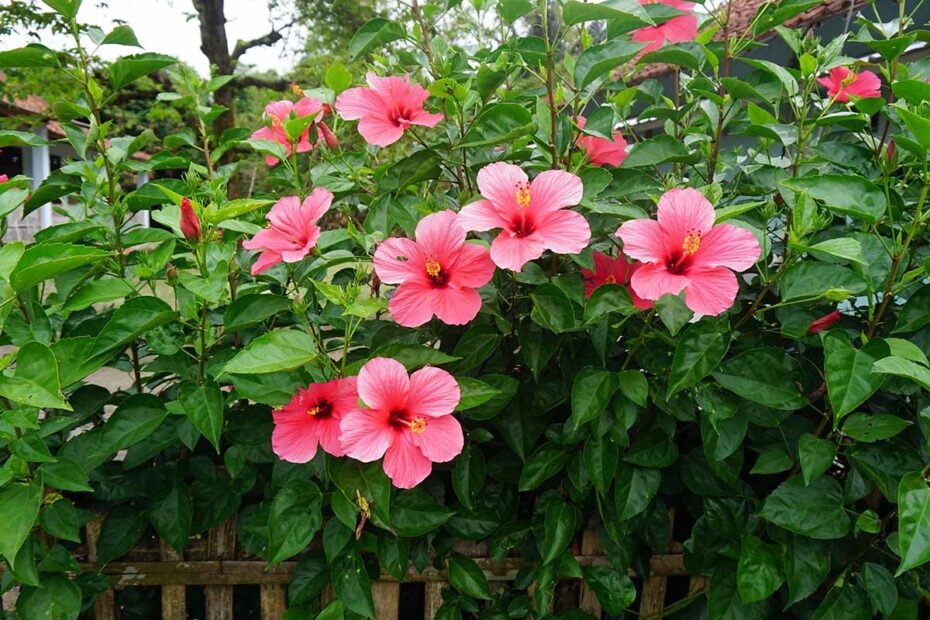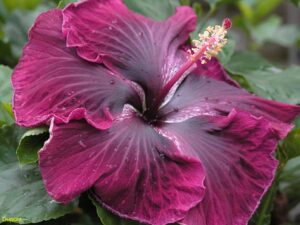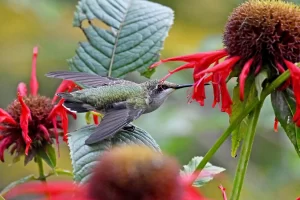Hibiscus Haven: Growing a Variety of Beautiful Shrubs
Hibiscus shrubs are a beautiful addition to any garden, providing vibrant blooms in a variety of colors. With their tropical appearance and easy care, hibiscus are a popular choice for gardeners of all skill levels.
This article will provide you with everything you need to know about growing hibiscus shrubs, from choosing the right variety for your climate to caring for your plants. So whether you’re a seasoned gardener or just starting out, read on to learn how to grow your own hibiscus haven.

Hibiscus Haven: Growing a Variety of Beautiful Shrubs
Hibiscus shrubs are a beautiful addition to any garden, and they come in a variety of shapes, sizes, and colors. With so many different types to choose from, you’re sure to find one that’s perfect for your yard.
Choosing the Right Hibiscus Shrub
When choosing a hibiscus shrub, there are a few things you’ll need to consider. First, think about the size of your yard. Hibiscus shrubs can range in size from a few feet tall to over 10 feet tall, so you’ll need to make sure you have enough space for the one you choose.
Second, consider the climate in your area. Hibiscus shrubs are generally hardy in zones 9-11, but there are a few varieties that can tolerate colder temperatures. If you live in a colder climate, you’ll need to choose a hibiscus shrub that’s specifically adapted for your area.
think about the color of the flowers you want. Hibiscus flowers come in a wide variety of colors, including red, pink, orange, yellow, and white. You can also find hibiscus shrubs with bi-colored or variegated flowers.
Growing Hibiscus Shrubs
Hibiscus shrubs are relatively easy to grow, but there are a few things you’ll need to do to keep them healthy.
- Plant your hibiscus shrub in a sunny location. Hibiscus shrubs need full sun to flower their best.
- Water your hibiscus shrub regularly. Hibiscus shrubs need to be watered regularly, especially during dry periods.
- Fertilize your hibiscus shrub every few months. Hibiscus shrubs benefit from a fertilizer that is high in phosphorus.
- Prune your hibiscus shrub regularly. Pruning your hibiscus shrub will help to keep it healthy and encourage new growth.
Hibiscus Shrubs: A Variety of Beautiful Options
There are many different types of hibiscus shrubs to choose from, each with its own unique characteristics. Here are a few of the most popular varieties:
- Hibiscus rosa-sinensis (common hibiscus): This is the most popular type of hibiscus shrub, and it’s known for its large, showy flowers. Common hibiscus shrubs can grow up to 10 feet tall, and they’re hardy in zones 9-11.
- Hibiscus syriacus (rose of Sharon): Rose of Sharon is another popular hibiscus shrub, and it’s known for its long, trumpet-shaped flowers. Rose of Sharon shrubs can grow up to 15 feet tall, and they’re hardy in zones 5-9.
- Hibiscus moscheutos (marsh hibiscus): Marsh hibiscus is a native North American species, and it’s known for its large, showy flowers. Marsh hibiscus shrubs can grow up to 6 feet tall, and they’re hardy in zones 5-9.
These are just a few of the many different types of hibiscus shrubs available. With so many different options to choose from, you’re sure to find a hibiscus shrub that’s perfect for your yard.
The Many Varieties of Hibiscus
The Many Varieties of Hibiscus
Hibiscus is a genus of flowering plants that includes over 250 species.
Hibiscus flowers come in a wide variety of colors, shapes, and sizes. They can be single or double, and they can range in size from a few inches to several feet across.These plants are native to tropical and subtropical regions around the world, and they are prized for their beautiful flowers..
Some of the most popular hibiscus varieties include:
- Hibiscus rosa-sinensis, also known as the Chinese hibiscus, is a large shrub that can grow up to 10 feet tall. It has large, showy flowers that come in a variety of colors, including red, pink, orange, yellow, and white.
- Hibiscus moscheutos, also known as the swamp rosemallow, is a perennial that grows in wet areas. It has large, trumpet-shaped flowers that come in a variety of colors, including pink, purple, and white.
- Hibiscus syriacus, also known as the rose of Sharon, is a deciduous shrub that blooms in summer. It has large, showy flowers that come in a variety of colors, including red, pink, purple, and white.
Hibiscus plants are easy to grow and care for. They prefer full sun and well-drained soil. They can be grown in containers or in the ground. Hibiscus plants are drought-tolerant and they can withstand a wide range of temperatures.
Hibiscus plants are a beautiful addition to any garden. They are also a great source of nectar for butterflies and hummingbirds.
How to Grow Hibiscus Shrubs
How to Grow Hibiscus Shrubs
Hibiscus shrubs are a beautiful addition to any garden, and they’re relatively easy to grow. With proper care, you can enjoy these colorful blooms for many years to come.
Step 1: Choose the right location
Hibiscus shrubs need full sun to thrive, so choose a spot in your garden that gets at least 6 hours of direct sunlight each day. They also need well-drained soil, so avoid planting them in areas that are prone to flooding.
Step 2: Prepare the soil
Before planting your hibiscus shrub, it’s important to prepare the soil. Dig a hole that is twice the width of the root ball, and mix in some compost or organic matter to improve drainage.
Step 3: Plant the shrub
Gently remove the hibiscus shrub from its container and place it in the hole. Backfill the hole with soil, and water the shrub thoroughly.
Step 4: Water regularly
Hibiscus shrubs need regular watering, especially during the hot summer months. Water your shrub deeply once a week, and more often if the weather is hot and dry.
Step 5: Fertilize monthly
To help your hibiscus shrub produce more blooms, fertilize it monthly with a balanced fertilizer. You can use a water-soluble fertilizer or a granular fertilizer.
Step 6: Prune as needed
Hibiscus shrubs can be pruned to maintain their shape and size. Prune your shrub in late winter or early spring, before the new growth begins.
Step 7: Enjoy your hibiscus shrub!
With proper care, your hibiscus shrub will reward you with beautiful blooms for many years to come.
Hibiscus Shrub Care Tips
- Hibiscus shrubs are susceptible to pests such as aphids, mealybugs, and scale. To control pests, spray your shrub with a horticultural oil or insecticidal soap.
- Hibiscus shrubs can also be affected by diseases such as powdery mildew and rust. To prevent diseases, water your shrub at the base and avoid overhead watering.
- Hibiscus shrubs are hardy in USDA zones 9-11. In colder climates, they can be grown as annuals or overwintered indoors.
Caring for Hibiscus Shrubs
Caring for Hibiscus Shrubs
Hibiscus shrubs are a beautiful addition to any garden, but they do require some care in order to thrive. Here are a few tips on how to care for your hibiscus shrubs:
- Water regularly. Hibiscus shrubs need to be watered regularly, especially during hot, dry weather. The best way to determine if your hibiscus needs water is to stick your finger into the soil. If the soil is dry to the touch, it’s time to water.
- Fertilize regularly. Hibiscus shrubs benefit from regular fertilization. You can use a balanced fertilizer, such as 10-10-10, or a fertilizer specifically formulated for hibiscus. Fertilize your hibiscus shrubs every 4-6 weeks during the growing season.
- Prune regularly. Hibiscus shrubs can get quite large, so it’s important to prune them regularly to keep them in shape. Prune your hibiscus shrubs in the spring, before new growth begins.
- Protect from pests and diseases. Hibiscus shrubs can be susceptible to a variety of pests and diseases, such as aphids, mealybugs, and powdery mildew. To protect your hibiscus shrubs from pests and diseases, you can use a neem oil spray or insecticidal soap.
By following these tips, you can help your hibiscus shrubs thrive and enjoy their beautiful blooms for years to come.
Table of Hibiscus Shrub Care Tips
| Tip | Description |
|---|---|
| Water regularly | Hibiscus shrubs need to be watered regularly, especially during hot, dry weather. |
| Fertilize regularly | Hibiscus shrubs benefit from regular fertilization. |
| Prune regularly | Hibiscus shrubs can get quite large, so it’s important to prune them regularly to keep them in shape. |
| Protect from pests and diseases | Hibiscus shrubs can be susceptible to a variety of pests and diseases. |
Hibiscus flowers are a beautiful and versatile addition to any garden. They can be used in a variety of ways, from adding color to your landscape to making delicious tea.
Harvesting hibiscus flowers
Hibiscus flowers are best harvested in the morning, when they are fully open. To harvest a hibiscus flower, simply grasp the stem near the base and gently pull it away from the plant. Be careful not to damage the flower.
Using hibiscus flowers
Hibiscus flowers can be used in a variety of ways, including:
- Adding to salads. Hibiscus flowers add a beautiful pop of color and flavor to salads. Simply add a few flowers to your favorite salad recipe.
- Making tea. Hibiscus tea is a delicious and refreshing way to enjoy hibiscus flowers. To make hibiscus tea, steep dried hibiscus flowers in hot water for 5-10 minutes.
- Making syrup. Hibiscus syrup is a delicious and versatile way to use hibiscus flowers. To make hibiscus syrup, simmer dried hibiscus flowers in water for 10-15 minutes. Strain the liquid and add sugar to taste. Hibiscus syrup can be used in a variety of recipes, including cocktails, lemonade, and iced tea.
- Making jelly. Hibiscus jelly is a sweet and tart way to enjoy hibiscus flowers. To make hibiscus jelly, simmer hibiscus flowers in water for 10-15 minutes. Strain the liquid and add sugar and pectin to make a jelly. Hibiscus jelly can be enjoyed on toast, biscuits, or pancakes.
Hibiscus flowers are a beautiful and versatile addition to any garden. They can be used in a variety of ways, from adding color to your landscape to making delicious tea.
Attracting Birds and Bees with Hibiscus Shrubs
Attracting Birds and Bees with Hibiscus Shrubs
Hibiscus shrubs are a beautiful addition to any garden, and they can also help attract birds and bees. Here are a few tips on how to attract these beneficial creatures to your yard with hibiscus shrubs:
- Plant a variety of hibiscus shrubs. Different types of hibiscus shrubs attract different types of birds and bees. For example, red hibiscus shrubs attract hummingbirds, while orange hibiscus shrubs attract orioles.
- Place hibiscus shrubs in a sunny location. Hibiscus shrubs need full sun to thrive, so make sure to plant them in a spot where they will get plenty of sunlight.
- Water hibiscus shrubs regularly. Hibiscus shrubs need regular watering, especially during hot summer months.
- Fertilize hibiscus shrubs in the spring and summer. Hibiscus shrubs benefit from a fertilizer that is high in nitrogen.
By following these tips, you can attract birds and bees to your yard with hibiscus shrubs. These beneficial creatures will help pollinate your plants, and they will also provide you with hours of enjoyment watching them flit about your garden.
| Type of Hibiscus Shrub | Attracts |
|---|---|
| Red Hibiscus Shrub | Hummingbirds |
| Orange Hibiscus Shrub | Orioles |
| Yellow Hibiscus Shrub | Bees |
| White Hibiscus Shrub | Butterflies |
Resources
1. The Spruce: Growing Hibiscus
This article from The Spruce provides detailed information on how to grow hibiscus, including tips on choosing the right variety, planting and caring for your plants, and dealing with pests and diseases.
2. Gardening Know How: Hibiscus Shrubs
This article from Gardening Know How offers another comprehensive guide to growing hibiscus, with information on everything from choosing the right location for your plants to dealing with common problems.
Concluding Remarks
Hibiscus Haven: Growing a Variety of Beautiful Shrubs
Hibiscus shrubs are a beautiful addition to any garden, providing a splash of color and interest throughout the growing season. With so many different varieties to choose from, there’s sure to be a hibiscus shrub that’s perfect for your home.
Whether you’re looking for a large, showy shrub or a smaller, more delicate one, hibiscus plants are sure to add beauty and charm to your garden. So what are you waiting for? Start growing your own hibiscus haven today!
Here are some tips for growing hibiscus shrubs:
- Choose a location that receives full sun.
- Plant your hibiscus shrub in well-drained soil.
- Water your hibiscus shrub regularly, especially during dry periods.
- Fertilize your hibiscus shrub monthly with a balanced fertilizer.
- Prune your hibiscus shrub to maintain its shape and size.
With proper care, your hibiscus shrub will reward you with beautiful blooms for years to come.
- Cat Palm vs Majesty Palm: Which Should You Choose? - June 30, 2024
- Flowers That Survive Winter: Discover the Exceptional No. 5 - June 30, 2024
- The Ultimate Guide to the Growth and Care of the Black Pagoda Lipstick Plant - June 29, 2024





